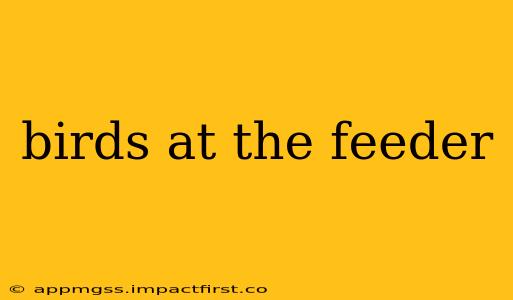Watching birds at your feeder can be a captivating and rewarding hobby. It's a window into the fascinating world of avian life, offering hours of entertainment and a chance to connect with nature right in your own backyard. But attracting a diverse range of birds and identifying them requires understanding their needs and preferences. This comprehensive guide will delve into the intricacies of bird feeding, offering expert tips and insights to enhance your birdwatching experience.
What Types of Birds Visit Feeders?
The types of birds that visit your feeder will largely depend on your location and the type of food you offer. Common feeder visitors include:
- Finches: These small, colorful birds are frequent visitors, drawn to seeds like niger seeds and sunflower seeds. American Goldfinches, House Finches, and Purple Finches are just a few examples.
- Chickadees & Titmice: These acrobatic birds love sunflower seeds, suet, and nuts. Black-capped Chickadees and Tufted Titmice are particularly common.
- Woodpeckers: Downy and Hairy Woodpeckers are attracted to suet, nuts, and sometimes seeds. They're easily identifiable by their striking markings and pecking behavior.
- Blue Jays: These larger, boisterous birds enjoy peanuts, sunflower seeds, and suet.
- Cardinals: Northern Cardinals, with their vibrant red plumage (males) and reddish-brown (females), are frequent visitors to feeders offering sunflower seeds and cracked corn.
What Kind of Bird Feeder Should I Use?
Choosing the right feeder is crucial for attracting a variety of birds. Different feeders cater to different feeding styles and bird sizes.
- Tube feeders: Ideal for smaller birds like finches, these feeders hold small seeds and often have perches.
- Hopper feeders: These larger feeders hold a greater quantity of seed and are suitable for a wider range of birds.
- Suet feeders: Designed to hold suet cakes or blocks, these feeders are perfect for attracting woodpeckers and other birds that appreciate high-fat foods.
- Platform feeders: These open feeders are suitable for a variety of birds but can also attract larger ground-feeding birds and may require more frequent cleaning.
How Often Should I Refill My Bird Feeder?
The frequency of refilling depends on the number of birds visiting your feeder and the capacity of the feeder itself. As a general rule, aim to refill your feeder when it’s about half empty, preventing birds from going hungry. Regularly checking and cleaning your feeder is essential to prevent the spread of disease.
What is the Best Bird Seed to Use?
Different birds prefer different types of seeds. A good mix usually includes:
- Sunflower seeds: A popular choice for a wide range of birds. Black oil sunflower seeds are especially favored.
- Niger seeds: Attracts finches, but it's best stored in a sealed container due to its high oil content.
- Nyjer seed: Another name for Niger seed, often sold in specialized feeders designed to prevent seed spillage.
- Cracked corn: Appeals to larger birds like doves and jays.
- White-striped sunflower seeds: A more economical option, though not always as appealing as black oil sunflower seeds.
How Can I Keep Squirrels Away From My Bird Feeder?
Squirrels are notorious for raiding bird feeders. Several strategies can help deter them:
- Squirrel-resistant feeders: These feeders have special baffles or cages designed to prevent squirrels from accessing the seed.
- Spicy birdseed: Adding chili flakes or cayenne pepper to the seed mix can deter squirrels, but may not affect all birds.
- Changing feeder locations: Moving the feeder regularly can make it harder for squirrels to locate it consistently.
What are the benefits of having birds at my feeder?
Beyond the sheer enjoyment of watching these fascinating creatures, having birds at your feeder offers several benefits:
- Pest control: Many birds consume insects, helping to keep your garden free from unwanted pests.
- Ecosystem balance: Supporting birds helps maintain the biodiversity of your local ecosystem.
- Educational opportunities: Observing birds can be a great learning experience for children and adults alike.
- Stress reduction: The calming presence of birds can reduce stress and enhance mental well-being.
By understanding the needs of your local bird population and implementing the right strategies, you can create a thriving bird-watching haven right in your own backyard. Remember to observe and learn from the birds you attract, enhancing your appreciation for the natural world.
